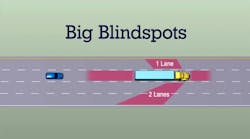The Federal Motor Carrier Safety Administration (FMCSA) launched a public outreach program that aims to show passenger vehicle drivers how to be safer around commercial motor vehicles, or CMVs.
Called "Our Roads, Our Safety," the program focuses on how to pass CMVs and the typically large blind spots where a tractor-trailer driver can't see the passenger vehicle. Passenger car drivers also are cautioned not to cut in too close in front of a heavy truck or bus, since CMVs have longer stopping distances and it creates a dangerous traffic environment.
Another point the program emphasizes is that tractor trailers and other CMVs can often cut a very tight turn, especially if towing a long trailer — the cab will make a wide turn, but the trailer shaves the corner considerably tighter.
:: More broadly, FMCSA's program offers 10 tips for the motoring public to follow to "coexist" better on America's roadways with big trucks and buses:
1. Stay out of "no zones," or blind spots, of heavy trucks and buses.
2. Pass commercial motor vehicles safely on the left, and when you pass, do so promptly. Don't creep forward slowly on that cruise control going just a few mph faster, as an example.
3. Don't cut in too closely in front of a CMV, not only because the CMV needs more stopping distance but also because the truck driver may not be able to see a passenger car for some ways in front of the truck, depending on the slope of the truck's or bus' hood.
4. Keep back a safe distance behind a truck or bus on the road. Don't tailgate.
5. Anticipate that a commercial truck, particularly a tractor-trailer, may need to cut a turn very sharply. Its trailer particularly will shave the corner very tightly when it comes around.
6. Be patient with large trucks and buses generally. In this case, FMCSA is addressing the often very fast-paced and intolerant — or to put a finer point on it, road raging — volatile nature of the nation's roadways today, pointing out that CMVs may have speed-limiting devices or have fleet policies to travel at lower speeds than highway traffic reaches.
"Honking, driving aggressively, or weaving through traffic won't make the trip faster, but can cause dangerous distractions and crashes," FMCSA stated under this sixth program item.
7. Buckle up. FMCSA also rolled in this likely most known and widely acknowledged government public safety message for all motorists.
8. Stay focused and put down any talking on a phone handset, texting and Internet use/ surfing while driving. Police around the country have called distracted driving the modern equivalent to the problem and prevalence of drunk driving decades ago.
9. Don't drive fatigued. Here's another problem commonly found on America's roadways in 2017, with American workers very commonly reporting being or feeling stressed, overworked or tired on the job or commuting to work. Truck drivers also face fatigue with the hours they work and regulations regarding how they must operate a CMV.
Avoid driving fatigued and get off the road safely and as soon as you can. But this is no simple matter; on the nation's roadways, finding a safe place to stop and rest in some places for any motorist or even to park a CMV is becoming a more and more frequent problem.
10. Don't drive under the influence, period. This final perennial point also is included in FMCSA's safety program and goes without saying: operating a vehicle can be dangerous enough even under ideal circumstances. Driving when your ability to operate a vehicle is impaired because of alcohol or drugs endangers yourself, your passengers, others on the road and people like pedestrians or cyclists near the road.
Go to www.fmcsa.dot.gov/ourroads for more info on the program, including educational materials and details on how to become a partner.



